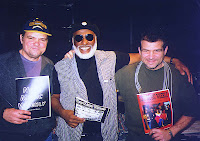NEW REVOLUTION FAVORS THE INDEPENDENT
Independent Artists Can Promote Themselves Better Than Ever
As independent record promoters, we have had the privilege to get an inside look at the music industry through the eyes of the radio industry. Talking to more than 400 radio stations a week gives a good perspective of what it is really like on "the other side.” Discussing problems and industry concerns, we get unique and up to date insight into what the radio industry is really looking for.
The # 1 question that we are asked by up- and- coming groups or artists is," Do I have to be on a major label to get radio airplay?"
The answer is, "No!" Since the start of the rap music revolution, stations have been deluged with independent releases. It soon became impossible to keep up with which act was actually attached to a sub-label of a company like Warner or Columbia. Hits were broken on some acts that had no distribution deal in place. Music and Program Directors threw up their hands and went back to the basics, relying on the so-called time tested adage, "if it sounds like a hit, then we’ll play it."
The Need for Secondary Market Radio Airplay Statistics:
As promoters, we are very seldom asked which label the record is on. Labels only come into play when there is a need for chart listings for the trade publications. One of the ways to break unsigned bands and new artists on independent labels is through secondary market radio stations. These "starter" stations are critical in order to get airplay for the lesser known artists. Armed with secondary market airplay statistics, and if the sound fits their particular format, we as promotion people can "open doors" at a number of stations across the country. Once we get enough of these smaller stations(amounting to over 250 across the U.S.), we can then graduate into the Nielson BDS and Clear Channel Mediabase stations.
Secondary Market to Primary Market Transition:
Even top labels have had to work these secondary radio markets in order to get something going for new acts. If you are not one of the "chosen few" that has a deal with the majors, the secondary radio market is one of the ways create your story and try to and make “it” happen. Both BDS and Mediabase are considered "top of the line" in market reporting and favor major label activity. Most primary market stations will not respond to new independent product unless it "has a story." In order to get the BDS and Mediabase radio stations to pay attention, we need to build a "story" with a station count in the secondary radio markets
An Opportunity for Independent Musicians and Labels:
Most of the major labels are favoring the top 100 markets in the country and ignoring the secondary radio market. These smaller stations have started to feel a lack of support from the major labels and are turning to independent labels and promotion people for product and service. Before the independent labels and promoters filled the void, some Music and Program Directors have had to go to the music stores and purchase the music that they need to play on air. As a result, some radio stations have pulled major labels and artists from their playlists. This has opened an opportunity to get independent product on the air, delivered directly to the Music and Program Director's desk, without a trip to the record store.
The #2 most asked question of us is, "Why get radio airplay when I have no distribution?"
It is our position that building a strong station count is the way to give you the ammunition you need to get a good distribution deal. You are then able to show a major label exactly where you record is being played by station call letter, city and state. This lets them know what territories they need to focus on immediately and it puts a sense of urgency in the mix to getting a deal in place.Many major labels have personnel in A&R departments, dedicated to reviewing small market radio playlists, looking to see what is starting to "break." The bottom line for most of radio is that if the product is good, is promoted to the right formats and serviced properly, it will get played.
>> More Info <<



